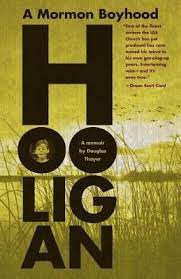Articles/Essays – Volume 41, No. 2
Innocent Hooligan | Douglas Thayer, Hooligan: A Mormon Boyhood
A staple of Douglas Thayer’s fiction is the sensitive, adolescent or young adult Mormon male struggling to come to terms with the burdens of mortality, a sense of sin, or the pressures of exemplary living. Now, in a memoir, Thayer deals more directly with his own experiences of growing up in the old Provo Sixth Ward during the 1930s and ’40s. Curiously, the authorial voice in the memoir is almost entirely devoid of the complicated inner life of Thayer’s fictional protagonists. He maintains a cool, rather detached, faintly ironic narrative tone throughout, with only oblique hints at something more deeply involved.
Thayer gives us a detailed inventory of the Depression- and World War II-era milieu through which he and his friends moved. The organization is topical, one topic following close upon another and often mingling the experiences of adolescence with those of early childhood.
Hooligan is a book of lists—not a bad thing in a social document: “Although healthy and active for the most part, we boys sometimes found ourselves diseased or wounded, or both. Measles, mumps, chicken pox, scarlet fever, whooping cough, rheumatic fever, polio, flu, sore throats, tonsillitis, infected ears, appendicitis, broken arms and legs, sprains, cuts, blood poisoning, and lockjaw. . .” (52). A fairly comprehensive catalogue of the ills to which flesh is susceptible. Even the chapter titles are random lists—“tomato soup, brutality, dancing, nosebleeds, fire escape”; or less random lists—“work, laziness, rotten laziness, damned rotten laziness.”
The overriding impression I gained from the happy abundance of remembered experiences is of the immense freedom enjoyed by small-town boys of an earlier generation. Thayer and his friends had no organized sports, no after-school programs, no lessons, no adults whose job it was to keep them safe or entertained. They attended school, had daily chores around the house, and were expected to get part-time jobs when they were old enough. But this left great stretches of free time for prowling the streets, looking into shops and pool halls, hunting, fishing, swimming naked at the Provo River swimming hole called the Crusher, building cardboard cities or fighting rubber-gun wars in vacant lots and abandoned sheds, and taking in the Saturday matinee double features at the Uinta Theater.
The author writes that he and his friends enjoyed thinking of themselves as “hooligans,” largely because “it had a nice sound” (38), but the level of hooliganism presented in the memoir is pretty mild, limited to such activities as smoking cedar bark, stealing the occasional egg from a neighbor’s chicken coop, or tossing rocks through the windows of derelict buildings. The boys cheerfully slaughtered as many fish, birds, and small mammals as came within reach of their hooks or firearms, and aspired, especially during the war, to larger and more destructive weaponry, but through it all there is an overriding sense of innocence. One charming moment occurs when the author, encountering for the first time a girl wearing a backless gown at a high school dance, discreetly covers his hand with his clean handkerchief to avoid the contact of flesh on flesh.
Hooligan is an enjoyable read, but I found myself wishing that Thayer had not so firmly avoided drawing upon the techniques of fiction in his autobiographical account. The long lists give a solidity of specification to the represented world; but in some instances, this effect could have been more effectively achieved by one or two selected, evocative details that could create a mood or set a scene. We learn a great deal about the author’s activities as a child but gain only a superficial insight into his thoughts and emotions. The word “sin” appears many times, but there is almost no sense of sinfulness or of struggling against personal imperfection. Nor, on the other hand, do we get much feeling for the spiritual or emotional content of the Church activities described. The others in the author’s remembered world—his parents, brothers and sisters, adult leaders, friends—are sketchy figures, without much human substance. It would be interesting to have more fully developed portraits of the author’s par ents: the aged, one-eyed father, who lives in a furnished room in back of a pool hall and who had offered to give the author a prized fishing rod if he would stay with him when the family broke up; even more, the crippled, tireless, no-nonsense mother who supports her family through the Depression by working as a cleaning woman in the homes of more prosperous Provo residents, maintaining her dignity through such small rituals as insisting that her employers provide a cup of tea in the afternoon. The memoir Thayer has given us is well worth the reading, but it makes us wish for the autobiographical novel he has chosen not to provide.
Douglas Thayer. Hooligan: A Mormon Boyhood. Provo, Utah: Zarahemla Books, 2007. 186 pp., paper, $14.95


 Back to full Issue
Back to full Issue

